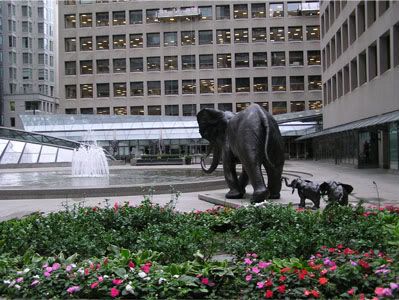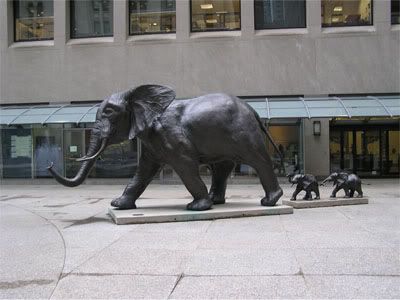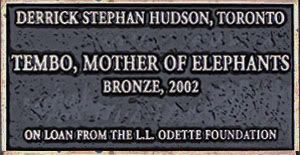 |
I suppose it is proper that an African elephant acquire an African name, even in the concrete jungle of downtown Toronto, and notwithstanding the financial references. Tembo in Swahili means "elephant." Still, Hudson could have come up with a more original name, like Rudyard Kipling's array of characters in The Jungle Book.
The sculpture is in the Commerce Court courtyard of the financial district, near the TD Centre, on loan from the L.L. Odette Foundation.
 |
Bronze, three pieces:
Mother elephant 9'1" high by 16' long
Two babies 2 '3" high by 4' wide
 |
The Artist, Derrick Stephan Hudson was born in the UK and moved to Canada as a child. He earned a Bachelor of History Degree before completing his studies at the Ontario College of Art and Design. Hudson’s work features wildlife forms in bronze, silver and stone and are included in private collections in Canada, the United States and the United Kingdom. (Source)Here's what the above link says about Hudson's technique:
Starting as a 20cm high model, Tembo was digitized. The 3D model was then scaled to allow the foundry to produce the 4 meter Bronze. Steinbichler White Light and laser Digitizing was the best tool to ensure that all of the necessary details were captured.The elephants are in the financial district of Toronto (near the TD Centre and the cow sculptures). I've tried to find out more about elephant symbolism in finance, but this is the best I could come up with, from Investopedia:
Combining white light pattern projection with CCD imaging technology, the Steinbichler system can capture millions of points to create multiple “point cloud” images. Using Poly Works Modeler software, a complete 3D point cloud model can then be accurately aligned and built. This 3D point cloud can then be polygonized for rapid viewing or rapid prototyping.
Tembo, a family of African elephants, cast at MST Bronze in Toronto, reflect the strength and loyalty of a mother for her children. The massive mother elephant weighs almost as much as 80 people or six automobiles and is one of the largest bronze elephants in the world.
Think of a swimming pool: if an elephant steps into the pool (buys into a position), the water level (stock price) increases; if the elephant gets out of the pool (sells a position), the water level (stock price) decreases. In comparison to the elephant's influence on stock prices, the effect of an individual investor is more like that of a mouse.And here:
Examples of elephants are professionally managed entities like mutual funds, pension plans, banks and insurance companies.
Contrarian investors specialize in doing the opposite of the elephants, that is, buying when institutions are selling, and selling when institutions are buying.
"How to Track the Market's "Big Money" Elephants":[Photos by KPA]
The stock market is dominated by large money managers... folks who run pension funds, insurance funds, mutual funds, and hedge funds.
Many of these managers control billions of dollars in client assets... and when they decide to enter or exit a position, they can't do it over just a few days. They have to spread their buying over months. They even have to hire people whose main job is to determine the best way to plow big money into individual stocks.
These big money managers are the "elephants" in the stock market. They create the huge moves that become market trends. And you can track elephant behavior with trading volume. [Continued]